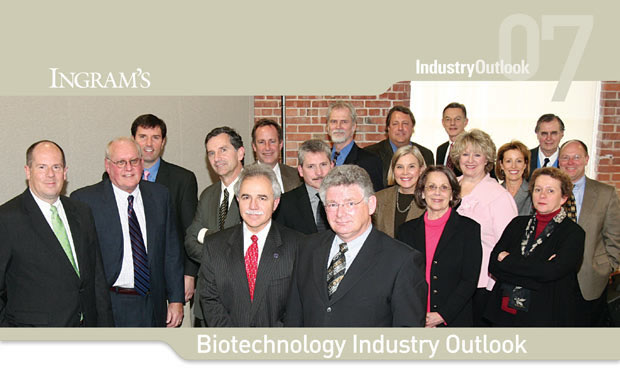(seated, left to right)
Kelly Gillespie, MO BIO
Bill Duncan, Kansas City Area Life Sciences Institute
Sean Hart, UBC Late Stage Group
John Gardner, University of Missouri System
James Guillory, Kansas City University of Medicine & Biosciences
Jeff Biskup, Clark Richardson & Biskup Consulting
Keith Gary, Kansas City Area Life Sciences Institute
Jake Halliday, Missouri Innovation Center
Jim Guikema, Kansas State University
Jeff Southard, VasoGenix Pharmaceuticals
Linda Cook, Midwest Research Institute
Joan Hunt, University of Kansas Medical Center
David Franz, Midwest Research Institute
Sandra Willsie, Kansas City University of Medicine & Biosciences
Lesa Mitchell, Kauffman Foundation
Beth Montelone, Kansas State University
Michael Chippendale, Chippendale Consulting, LLC, Scott Weir, University of Kansas Medical Center
BioSciences Surge Into the Future
That 2006 proved to be an eventful year for the life sciences in Kansas City no one could deny. The twenty or so life science leaders, who gathered at Ingram’s offices in the Freight House District early January, were eager to compare notes.
The assembly was part of Ingram’s widely read and highly praised Industry Outlook series. Chairing the session was Bill Duncan, president of the Kansas City Area Life Sciences Institute (KCALSI), which co-sponsored the event with Midwest Research Institute (MRI) and Kansas State University.
This year, those gathered not only cited past progress, but they also suggested some highly creative and productive paths to the future.
Challenges
The overall mood of the assembly was optimistic and upbeat. Although fully aware of the challenges they face, participants did not shy from facing them head on. “I don’t know what we would be doing if there weren’t challenges,” said Lesa Mitchell with the Kauffman Foundation. “I just can’t figure out what’s the biggest one.”
“The biggest challenge for the University of Missouri,” said John Gardner, vice president for research and economic development, “is to be a public research institution in the new economy.” This involves preparing students to not only get jobs but also to create jobs. It also means enabling the faculty to be active participants in the new economy as educators and researchers.
«January 2007 Edition
